Nothing beats the satisfying combination of steak and pasta, especially when they’re brought together in one incredible dish. Furthermore, this creamy steak pasta recipe proves that you can create restaurant-quality meals at home without breaking a sweat.
What makes this steak and pasta pairing so irresistible is the rich cream sauce that perfectly bridges both flavors. Additionally, the entire dish comes together in just 35 minutes, making it ideal for busy weeknights or special occasions alike.
Moreover, this recipe takes all the guesswork out of combining these two beloved ingredients. Consequently, you’ll end up with tender, perfectly seasoned steak served over creamy pasta that’s guaranteed to impress family and friends. Therefore, whether you’re cooking for date night or Sunday dinner, this steak and pasta combination delivers every single time.
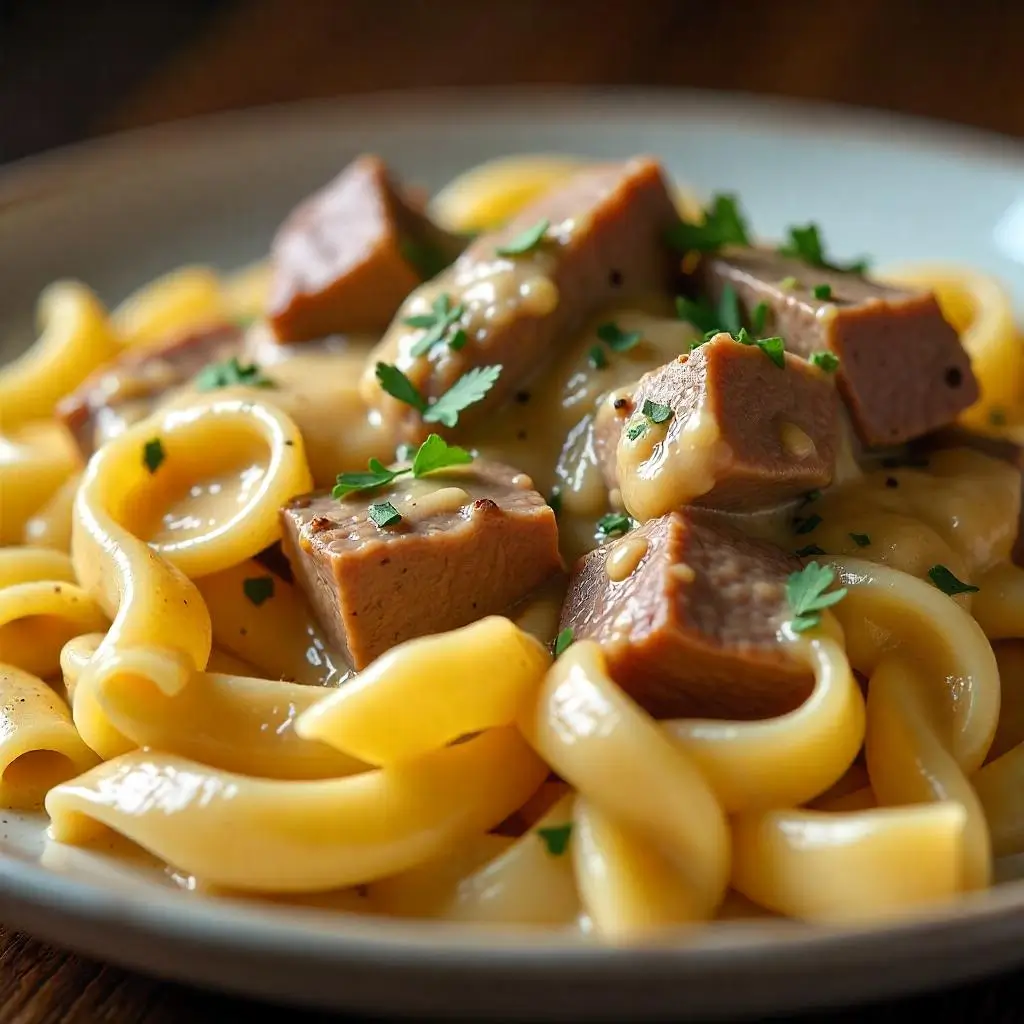
Table of content :
- Why You'll Fall in Love with This Steak and Pasta
- Quick Overview of Your Steak and Pasta Recipe
- Essential Ingredients for This Beef Steak and Pasta Dish
- Step-by-Step Instructions for Perfect Creamy Steak and Pasta
- Helpful Tips and FAQ for Creamy Steak and Pasta
- Share Your Experience with This Steak and Pasta Recipe
- Recipe Variations
- Storage Instructions
- Nutrition Information (Per Serving – Serves 4)
- Other recipe :
Why You’ll Fall in Love with This Steak and Pasta
As someone who has spent countless hours perfecting pasta recipes, I can confidently say this creamy steak pasta has become one of my absolute favorites. Furthermore, it combines the best of both worlds – the hearty satisfaction of a perfectly cooked steak with the comforting embrace of creamy pasta.
What makes this dish particularly special is how the flavors complement each other so beautifully. Additionally, the rich cream sauce acts as the perfect bridge between the robust beef flavors and the tender pasta, creating a harmonious blend that’s both sophisticated and comforting. Whether you’re planning a romantic dinner for two or looking for an impressive weeknight meal that doesn’t require hours in the kitchen, this recipe delivers on all fronts.
The yummy, creamy texture of this dish is what sets it apart from other steak and pasta combinations. Not only does it satisfy your cravings, but it also presents beautifully on the plate, making it perfect for both special occasions and casual family dinners.
Quick Overview of Your Steak and Pasta Recipe
Before we dive into the details, let’s look at what makes this recipe so appealing from a time management perspective:
- Preparation Time: 10 minutes
- Cooking Time: 25 minutes
- Total Time: 35 minutes
Consequently, this recipe falls perfectly into the category of quick and accessible steak pasta recipes that busy families can actually manage on a regular basis. Unlike more complicated dishes that require extensive prep work, this creamy steak pasta comes together efficiently while still delivering restaurant-quality results.
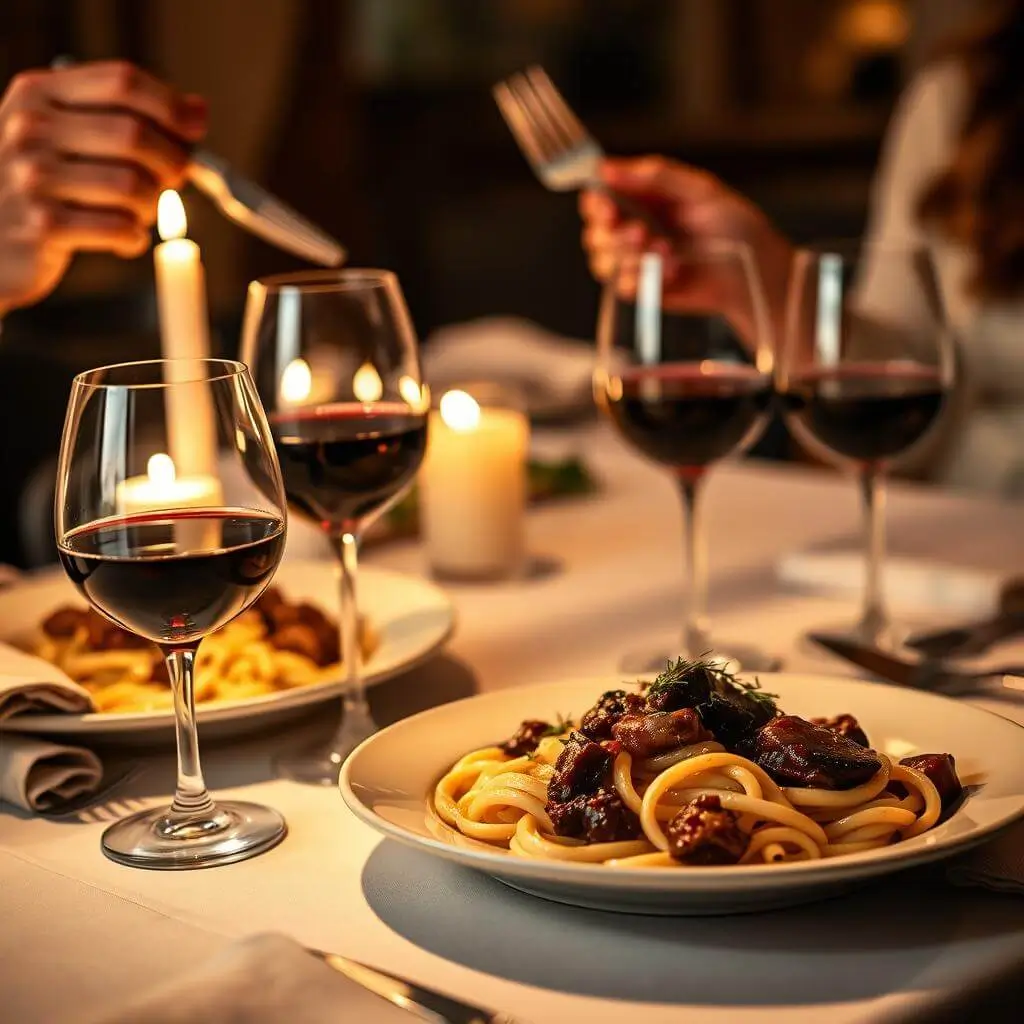
Essential Ingredients for This Beef Steak and Pasta Dish
To create this masterpiece, you’ll need the following carefully selected ingredients:
For the Steak:
- 2 tablespoons olive oil
- Salt and freshly ground black pepper
- 2 strip steaks (about 8 oz each), at room temperature
- 1 teaspoon garlic powder
- 1 teaspoon dried thyme
For the Creamy Sauce:
- 3 cloves garlic, minced
- 1/2 cup dry white wine (optional)
- 3 tablespoons butter
- 1 1/2 cups heavy cream
- 1/2 cup beef broth
- 3/4 cup freshly grated Parmesan cheese
- 1/2 teaspoon Italian seasoning
- Red pepper flakes to taste
For the Pasta:
- 12 oz Rigatoni pasta (or your preferred shape)
- Fresh parsley for garnish
- Additional Parmesan for serving
The choice of strip steaks is particularly important because they provide the perfect balance of tenderness and flavor. Similarly, using fresh Parmesan cheese rather than pre-grated makes a significant difference in both taste and texture of the final sauce.
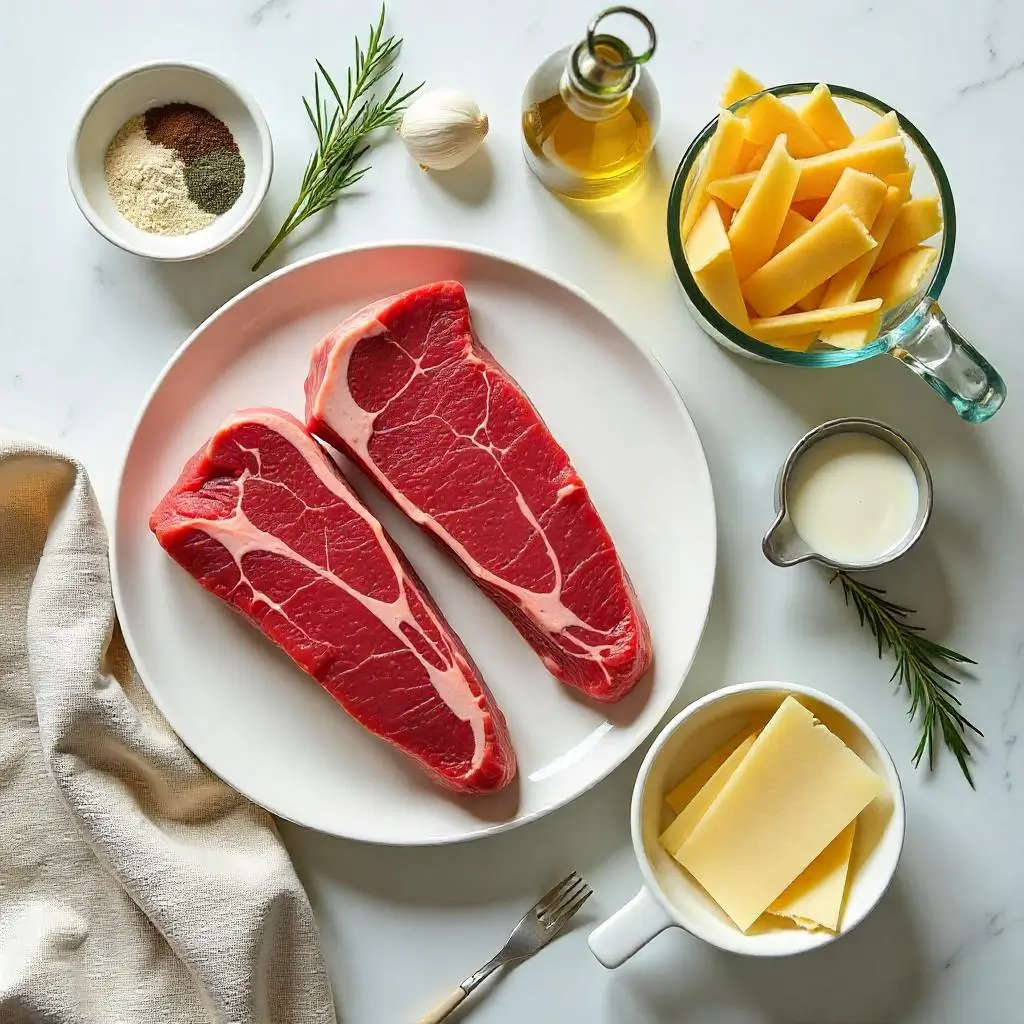
Step-by-Step Instructions for Perfect Creamy Steak and Pasta
Step 1: Prepare the Pasta Water
First, bring a large pot of salted water to boil. Meanwhile, this gives you time to season and prep your steaks properly.
Step 2: Season and Cook the Steaks
Pat the steaks dry and season generously with salt, pepper, garlic powder, and thyme. Next, heat olive oil in a large skillet over medium-high heat. Cook the steaks for 3-4 minutes per side for medium doneness, then set them aside to rest. This resting period is crucial for maintaining juicy, tender meat.
Step 3: Start the Pasta
While the steaks are resting, add the rigatoni to the boiling water. Cook according to package directions until al dente, then reserve 1 cup of pasta water before draining
Step 4: Create the Creamy Sauce
In the same skillet used for the steaks, reduce heat to medium and add butter. Once melted, add minced garlic and cook for 30 seconds until fragrant. Then, if using wine, add it now and let it reduce by half.
Step 5: Build the Cream Base
Pour in the heavy cream and beef broth, stirring constantly. Subsequently, bring the mixture to a gentle simmer and let it reduce slightly for about 5 minutes. This reduction process concentrates the flavors beautifully.
Step 6: Add Cheese and Seasonings
Remove the skillet from heat and gradually whisk in the Parmesan cheese until smooth. Add Italian seasoning and red pepper flakes according to your preference. If the sauce seems too thick, gradually add reserved pasta water until you reach the desired consistency.
Step 7: Combine and Serve
Add the drained pasta to the skillet and toss everything together until well coated. Meanwhile, slice the rested steaks against the grain into thin strips. Finally, serve the creamy pasta in bowls topped with sliced steak, fresh parsley, and additional Parmesan cheese.
Share Your Experience with This Steak and Pasta Recipe
Have you tried this creamy steak pasta recipe? I’d love to hear about your experience! Please leave a comment below sharing how it turned out, any modifications you made, or questions you might have.
Additionally, if you enjoyed this recipe, consider pinning it to your Pinterest boards so you can easily find it again. Furthermore, sharing your cooking photos on social media helps other home cooks discover this delicious combination of steak and pasta.
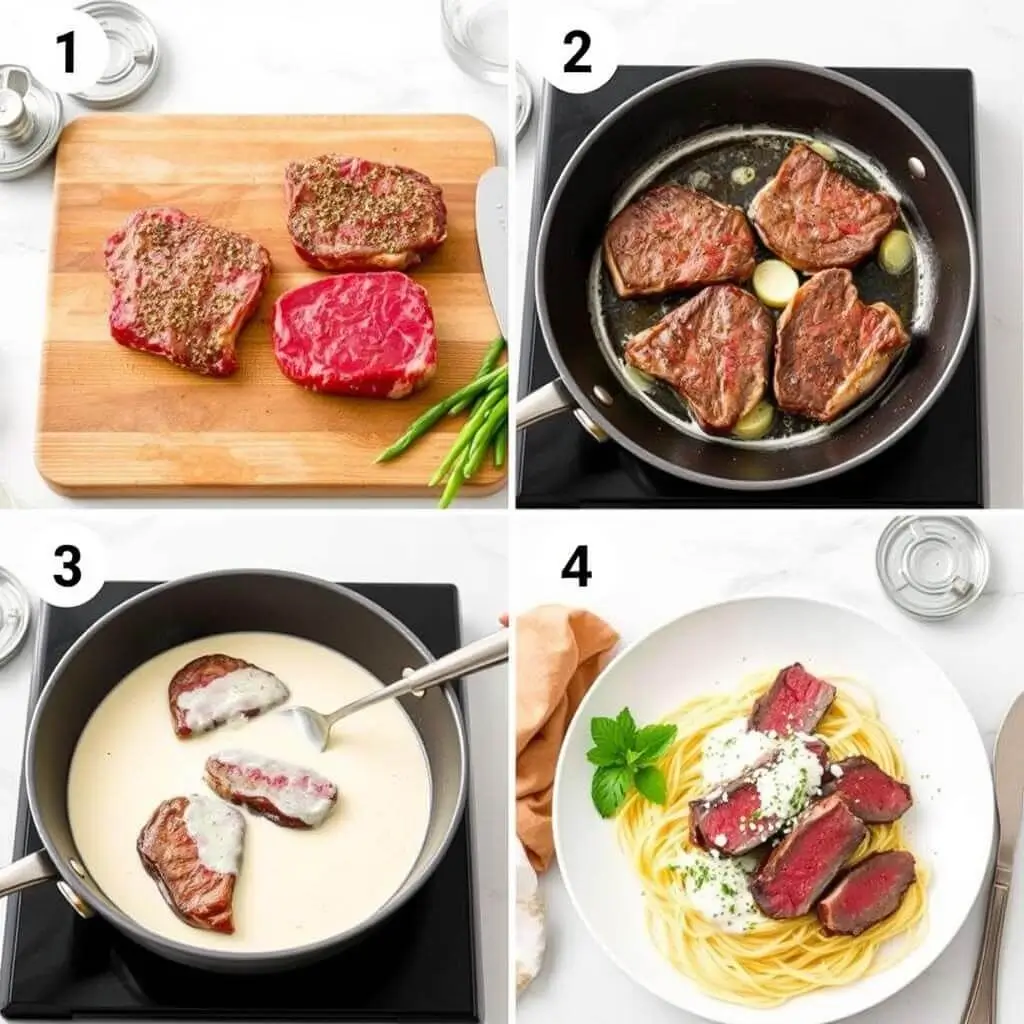
Recipe Variations
Protein Variations
- Chicken Steak Pasta: Replace beef with grilled chicken breast or thighs
- Shrimp Version: Use large shrimp (1 lb) instead of steak, cook 2-3 minutes per side
- Steak Tips: Cut steak into bite-sized pieces for easier eating
- Surf & Turf: Combine steak with shrimp for ultimate indulgence
- Pork Tenderloin: Slice and sear pork tenderloin as steak substitute
Sauce Variations
- Mushroom Cream: Add 8oz sliced mushrooms with garlic
- Sun-Dried Tomato: Include 1/2 cup chopped sun-dried tomatoes
- Cajun Spiced: Add 2 tsp Cajun seasoning and diced bell peppers
- Garlic Herb: Double the garlic, add fresh thyme and rosemary
- Wine-Free Version: Replace wine with additional beef broth
Pasta Alternatives
- Fettuccine: Classic choice for cream sauces
- Penne: Similar to rigatoni, holds sauce well
- Papardelle: Wide ribbons perfect for chunky sauce
- Gnocchi: For a heartier, potato-based option
- Zucchini Noodles: Low-carb spiralized zucchini alternative
Vegetable Add-Ins
- Spinach: Wilt 4 cups fresh spinach into sauce
- Asparagus: Add trimmed spears in last 5 minutes
- Broccoli: Steam and fold in before serving
- Bell Peppers: Sauté with garlic for color and crunch
- Cherry Tomatoes: Halved and added for freshness
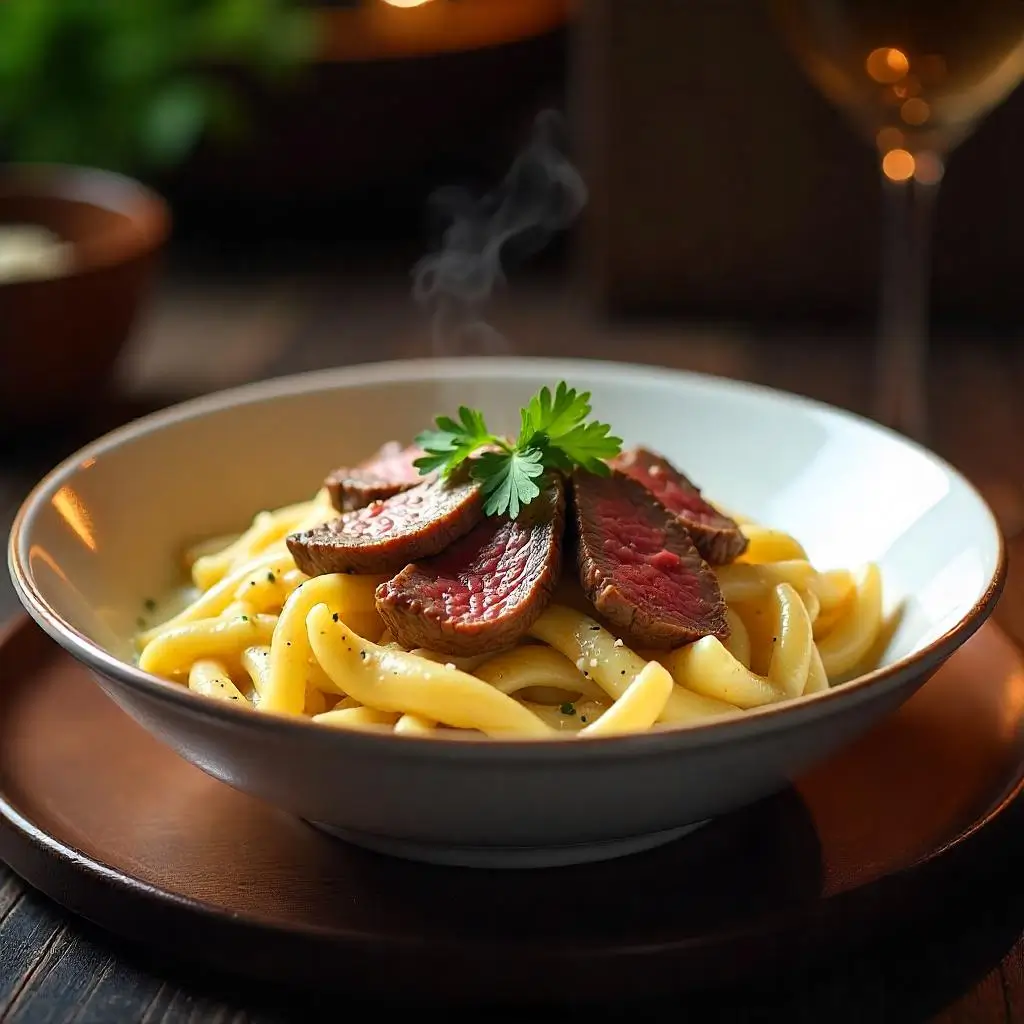
Storage Instructions
Refrigerator Storage
- Timeframe: 3-4 days maximum
- Container: Airtight glass or plastic containers
- Separation: Store pasta and steak separately if possible
- Cooling: Allow to cool completely before refrigerating
- Portion Control: Divide into individual serving containers
Freezer Storage
- Timeframe: Up to 3 months
- Best Practice: Freeze sauce and pasta together, steak separately
- Containers: Freezer-safe bags or containers, remove excess air
- Labeling: Date and contents clearly marked
- Note: Cream sauces may separate slightly when frozen
Reheating Instructions
- Stovetop Method: Heat gently over low heat, add splash of cream or broth if needed
- Microwave: Heat in 30-second intervals, stirring between
- Oven Method: Cover with foil, heat at 350°F for 15-20 minutes
- Fresh Garnish: Add fresh Parmesan and parsley after reheating
- Avoid: High heat which can cause sauce to curdle
Nutrition Information (Per Serving – Serves 4)
- Calories: 785
- Total Fat: 42g
- Cholesterol: 165mg
- Sodium: 890mg
- Total Carbohydrates: 68g
- Protein: 38g
- Vitamin A: 25% DV
- Calcium: 35% DV
- Iron: 20% DV
Helpful Tips and FAQ for Creamy Steak and Pasta
What pasta shapes work best? While rigatoni is recommended because its ridges hold the sauce beautifully, other excellent choices include penne, fusilli, or even fettuccine. However, avoid delicate pasta shapes that might break apart when tossed with the robust sauce.
Can I use pre-grated cheese? Although convenient, freshly grated Parmesan melts much more smoothly and provides superior flavor. Furthermore, it prevents the grainy texture that sometimes occurs with pre-packaged cheese.
How do I adjust the steak doneness? For rare steaks, cook 2-3 minutes per side; for medium-well, increase to 4-5 minutes per side. Additionally, using a meat thermometer ensures accuracy: 125°F for rare, 135°F for medium, and 145°F for medium-well.
Can I make this spicier? Absolutely! Start with a pinch of red pepper flakes and adjust to taste. Alternatively, you can add a dash of hot sauce or even some diced jalapeños to the garlic while sautéing.
What if my sauce is too thin? Simply simmer it a bit longer to reduce, or create a slurry with cornstarch and cold broth. Conversely, if it’s too thick, thin it out with reserved pasta water or additional cream.
This versatility makes this recipe a standout among pasta dishes with steak, allowing you to customize it to your family’s preferences while maintaining the core delicious elements that make it special.
Other recipe :
In conclusion, this creamy steak pasta recipe truly represents the perfect harmony between simplicity and sophistication. Moreover, it proves that you don’t need to spend hours in the kitchen or master complex techniques to create a restaurant-quality meal that will impress both family and guests.
Throughout this recipe, we’ve seen how carefully selected ingredients work together to create something truly special. Furthermore, the combination of perfectly seasoned steak, al dente pasta, and rich cream sauce demonstrates that sometimes the most satisfying meals come from classic flavor pairings executed with attention to detail.
What makes this dish particularly appealing is its incredible versatility. Additionally, whether you’re cooking for a romantic date night, a family celebration, or simply treating yourself to a comforting weeknight dinner, this creamy steak pasta adapts beautifully to any occasion. The recipe’s flexibility also means you can easily customize it to suit different tastes and dietary preferences.
Most importantly, this recipe delivers consistent results that will build your confidence in the kitchen. Consequently, once you master this technique, you’ll find yourself returning to it again and again, possibly even developing your own creative variations along the way.
Finally, remember that great cooking is about more than just following instructions—it’s about creating memories and bringing people together. Therefore, I encourage you to make this recipe your own, share it with loved ones, and enjoy every delicious bite of this exceptional creamy steak pasta. Happy cooking!
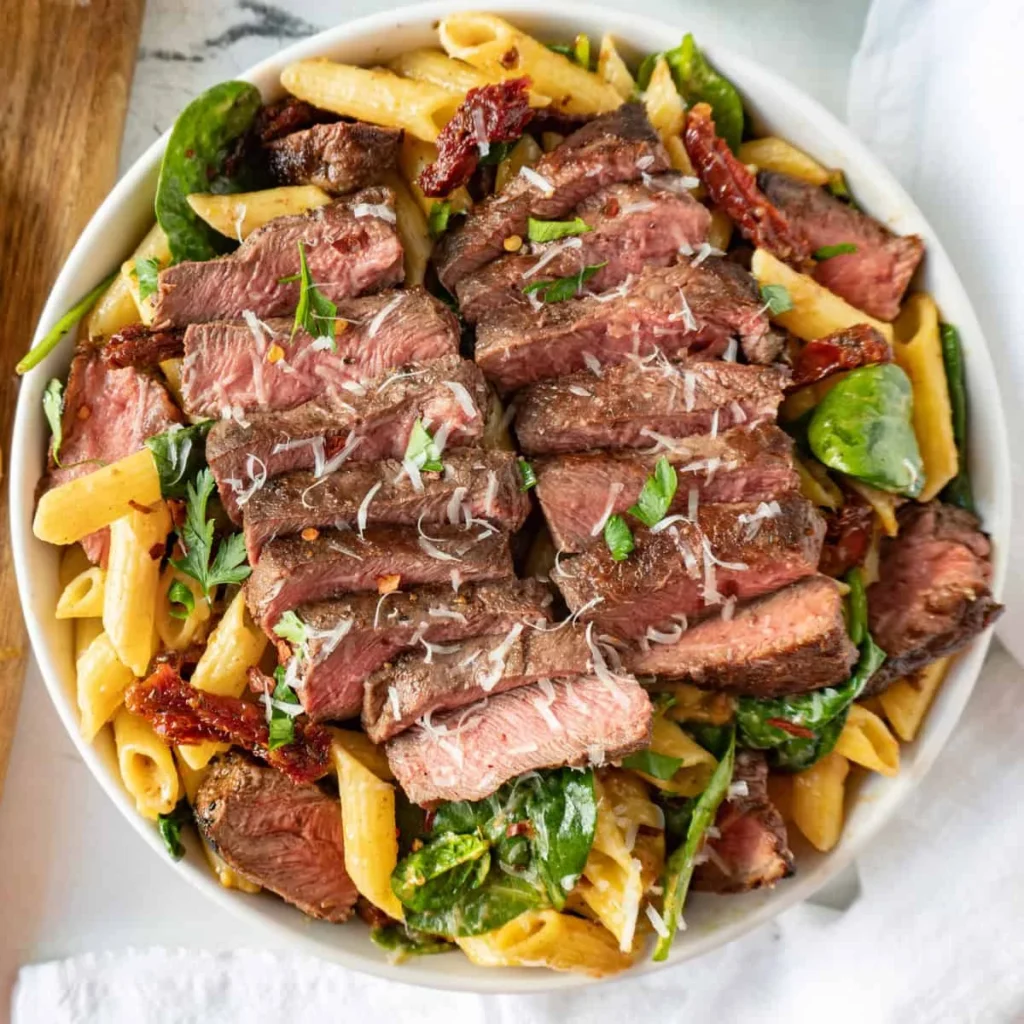
“Steak and Pasta Recipes You’ll Want to Try Tonight”
Description
“Discover irresistible steak and pasta recipes perfect for dinner tonight—quick, delicious, and satisfying meals your whole family will love!”
Ingredients
For the Steak
For the Pasta
Instructions
- Prepare Pasta Water
- Bring a large pot of salted water to boil for the pasta.
- Season & Cook Steaks
- Pat steaks dry and season with salt, pepper, garlic powder, and thyme. Heat olive oil in large skillet over medium-high heat. Cook steaks 3-4 minutes per side for medium doneness. Set aside to rest.
- Cook the Pasta
- Add rigatoni to boiling water and cook until al dente. Reserve 1 cup pasta water before draining.
- Start the Sauce
- In same skillet, reduce heat to medium and add butter. Add minced garlic and cook 30 seconds. Add wine if using and let reduce by half.
- Create Cream Base
- Pour in heavy cream and beef broth, stirring constantly. Bring to gentle simmer and reduce for 5 minutes.
- Add Cheese & Season
- Remove from heat and gradually whisk in Parmesan until smooth. Add Italian seasoning and red pepper flakes. Adjust consistency with pasta water if needed.
- Combine & Serve
- Add drained pasta to skillet and toss until well coated. Slice rested steaks against the grain. Serve pasta topped with sliced steak, fresh parsley, and additional Parmesan.
Instructions
Notes
- Looking for a hearty and satisfying meal? These steak and pasta recipes combine rich flavors and easy prep for the perfect dinner any night of the week.
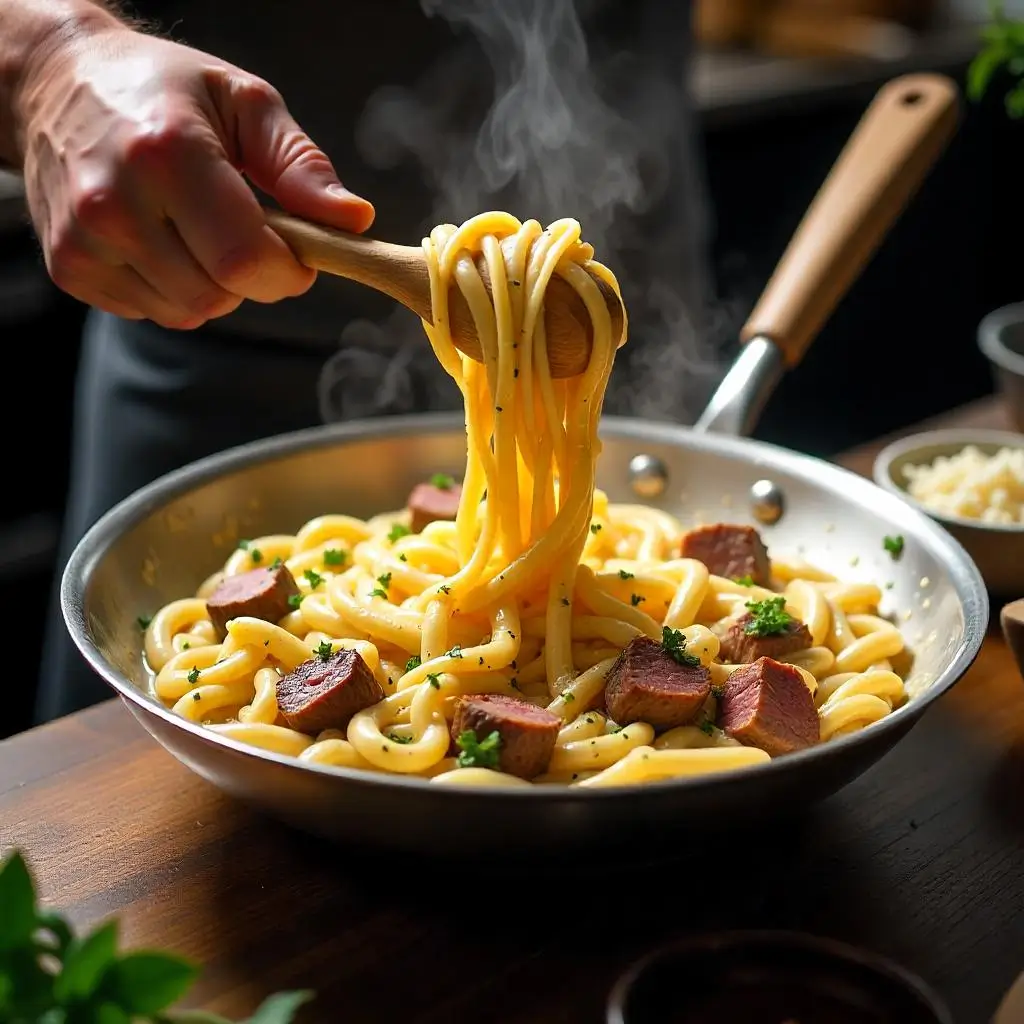
February 20, 2025 at 11:49 am[…] Steak and Pasta […]